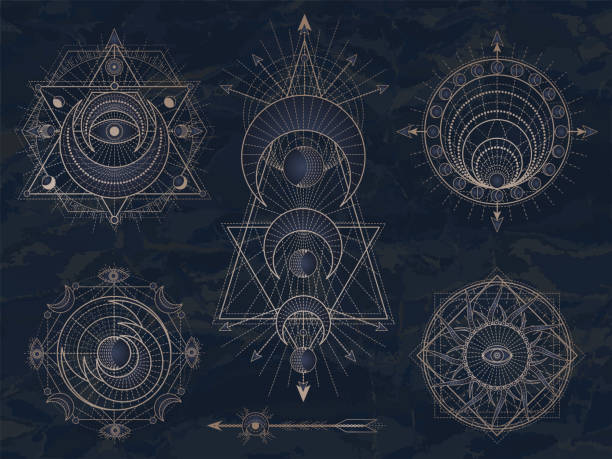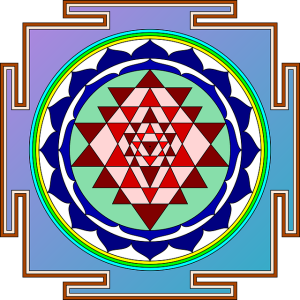
Not long ago, sacred geometry to me meant psychedelic diagrams hung on the walls of New Age stores or unusual geometric designs found in yoga studios. I never would have believed that these symbols could actually be used for spiritual enhancement. The study and utilization of shapes and patterns considered spiritually energetic has been present in various spiritual practices across different cultures and religions for thousands of years. Tracing the origins of its use in spiritual traditions leads us back to the prehistoric times, making it one of humanity’s oldest spiritual expressions. Evidence of sacred geometry can be found in the art and architecture of ancient civilizations – such as the Egyptians, Sumerians and Indians – dating back over 5,000 years ago. These early cultures regularly incorporated geometric patterns into their temples, pyramids, and art, believing these shapes held divine significance and mirrored the order of the cosmos.
For instance, the perfect alignment and proportions of the Egyptian pyramids, particularly the Great Pyramid of Giza, showcase an early and sophisticated use of geometric principles. These practices suggest that even in ancient times, people perceived a deep connection between sacred geometry and the spiritual realm, viewing these patterns and shapes as a means to represent and understand the mysteries of the universe and the divine.
In relatively modern times, this spiritual practice is found particularly within Hinduism (Sanatana Dharma), Judaism (Kabbalah), Buddhism, Shamanism and Christianity, offering insights into the universal language of symmetry, harmony and energy that these shapes represent.

Hinduism (Sanatana Dharma) and Yantras
In Hinduism, sacred geometry is prominently featured in the form of Yantras. These are geometric diagrams used as tools for meditation and spiritual advancement. The most famous Yantra is the Sri Yantra, which represents the universe’s creation and the union of the divine masculine and feminine, or Shiva and Shakti. It is composed of nine interlocking triangles that radiate outwards from a central point, symbolizing the cosmos’s infinite nature. Practitioners meditate on the Sri Yantra, often accompanied by a specific mantra, and focus on its center or Bindu point to attain higher states of consciousness and connect with their chosen Deity.
Judaism and the Kabbalah
Jewish mysticism, particularly Kabbalah, also makes use of sacred geometry. The Tree of Life, a fundamental symbol in Kabbalah, is a geometric representation of the divine structure of the universe. It consists of ten interconnected nodes or Sefirot, which represent different aspects of God’s creation and attributes. Kabbalists meditate on the Tree of Life, contemplating each Sefira to understand the divine nature and how it manifests in the world. This practice aims to achieve spiritual enlightenment and a deeper understanding of God.
Buddhism and Mandalas
Buddhism utilizes sacred geometry in the form of Mandalas. These geometric patterns represent the universe and are used as meditation aids to help practitioners focus their minds and achieve a state of enlightenment. The most renowned example is the Sand Mandala, meticulously created by Tibetan monks using colored sand. The process of creating and subsequently destroying the Mandala symbolizes the Buddhist belief in the transitory nature of material life. Meditating on a Mandala can help Buddhists understand the impermanence of the physical world, the importance of present awareness and the interconnectedness of all things.
Shamanism and Healing
Sacred geometry holds a significant place in shamanic traditions, where it is seen as a fundamental framework through which the natural world and spiritual realms are interconnected. In many shamanic cultures, geometric patterns and symbols are believed to represent the underlying structure of the universe, resonating with the energies of the earth, the cosmos, and the spirit world. These patterns are most often used in ritualistic healing practices and serve as conduits for spiritual energies and as tools for understanding and interacting with the unseen forces of nature.
Christianity and Architecture
Christianity has a rich tradition of incorporating sacred geometry into its art and architecture. The design of many European cathedrals, such as Notre Dame in Paris, is based on geometric principles that symbolize divine order and the universe’s harmony. The use of the golden ratio, a mathematical ratio found in nature that is aesthetically pleasing and harmonious, is evident in the proportions of these buildings. Additionally, the Rose Window, a prominent feature in Gothic cathedrals, is a prime example of sacred geometry. It’s often designed with intricate patterns that represent the Christian concept of heavenly order and the presence of God in the universe.
In the religious tradition in which I was raised, the Salt Lake City Mormon Temple, a historic and sacred landmark of The Church of Jesus Christ of Latter-day Saints, incorporates sacred geometry in its design. The temple’s architecture is rich with symbolic geometric elements, including the use of squares and rectangles that signify stability, foundation, and the earth, aligning with the Church’s emphasis on family and community. The repeated use of circles and arches throughout the temple symbolizes eternity and the divine nature of life, resonating with Mormon teachings of eternal progression and the eternal nature of families. Additionally, the six spires of the temple, three on the east and three on the west, are significant in their geometric arrangement, representing the Mormon priesthood authority and the connection between heaven and earth. This fusion of geometric shapes not only contributes to the temple’s majestic aesthetic but also deeply embeds the principles of the faith into its very structure, making it a profound example of sacred geometry in religious architecture.

Integrating Sacred Geometry in Modern Spiritual Practice
Meditation and Visualization: Practitioners of various faiths can incorporate sacred geometry into their meditation practices. By visualizing geometric symbols like the Sri Yantra or the Tree of Life, one can focus their mind and explore the deeper spiritual meanings these symbols represent.
Art and Creativity: Creating artworks based on sacred geometry can be a meditative practice in itself. Drawing Mandalas or designing geometric patterns can be a form of spiritual expression and a way to connect with the divine.
Architectural Harmony: Just as with ancient cathedrals, modern architects and designers can use sacred geometry principles to create spaces that evoke a sense of peace and spiritual harmony. This approach can be seen in religious buildings, meditation centers, and even personal living spaces.
Educational Study: Studying sacred geometry’s role in different spiritual traditions can provide valuable insights into the universal aspects of human spirituality. It can be a bridge for interfaith dialogue and understanding.
Yoga and Somatic Work: Practices like Yoga integrate geometric postures and movements, symbolizing cosmic order and the balance between physical and spiritual worlds. By understanding and practicing these postures, one can align themselves with these universal patterns.
The Natural World: Shamans, for example, frequently use sacred geometric shapes in their rituals to create sacred spaces, such as in the layout of altars or the arrangement of objects used in ceremonies. The use of circles, for instance, is common in shamanic rituals, symbolizing the cycle of life, the sun, the earth, and the concept of eternity.
Sacred geometry serves as a bridge between the physical and spiritual worlds, offering a visual medium through which practitioners can explore and experience the divine. From the Yantras of Hinduism and Mandalas of Buddhism to the Tree of Life in Kabbalah and the architectural marvels of Christianity, these geometric patterns provide a universal language that transcends cultural and religious boundaries. Integrating sacred geometry into spiritual practice, whether through meditation, art, architecture, education, or physical movement, can deepen one’s spiritual journey, leading to greater understanding and enlightenment.













